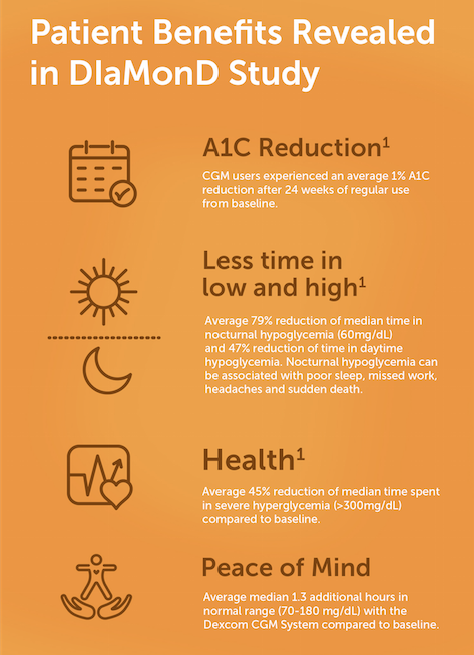The Power of the CGM
Can a continuous glucose monitor (CGM) do more than lower my A1C?
A new study published by Dexcom would say, “yes” and more.
The 24-week trial looked at how effective CGMs are at controlling blood sugar levels and found a wide-range of benefits in type 1 diabetes management that included but was not limited to lowering A1Cs.
Conducted in 24 different endocrinology practices in the US, the study involved 158 randomized adults with the average age of 48 and who had A1C levels of 7.5% to 9.9%.
By the end of the study, participants saw a reduction in A1C levels by 1.0% and nearly a quarter of participants in the CGM group had an A1C of less than 7.0%. It proves that using a CGM helps in better glycemic control.
“We were hopeful that we would see that,” says David Price, MD, Dexcom’s VP of Medical Affairs, who helped conduct the study.
In part, this could be because of the additional information you receive. Compared to testing blood glucose levels (BGLs) with a meter several times a day, a CGM gives you readings every five minutes and trending information with high and low BGL alerts.
The clinical trial is also unique in that it included individuals who were not on insulin pumps. Participants had previously been on multiple daily injections (MDIs) and were given a Dexcom G4 Platinum CGM System. The majority of adults with type 1 diabetes use insulin injections, but have not been in studies that look at the effectiveness of adding a CGM to care. Results of the study may paint a more accurate picture of management benefits for the larger population.
“I think there was the belief that patients on pumps were more likely to use wearable technology,” says Price. “What DIAMOND Randomized Clinical Trial showed us is that people who take injections derived the same benefits as people on pumps.”
Dana Howe, social media manager at Beyond Type 1, who has been on MDIs for 13 years for type 1 diabetes management, added a CGM to her care and described being excited about being able to see the direction her blood sugar was headed, even more than knowing just the number. She says, “My A1C dropped slightly without making other changes. I also now have fewer severe lows, especially in the middle of the night.”
In addition to a lowered A1C, patients saw the following benefits:
- Reduced duration of hypoglycemia
- Reduced duration of hyperglycemia
- Reduced glucose variability
- Better hypoglycemia awareness
- Decrease in frequency of blood glucose meter testing in CGM group
Another intriguing result of the study was “the observed benefits of CGM occurred despite the CGM group’s having significantly less blood glucose testing per day than the control group.” [1]
Price explains, “This was an interesting finding. The testing frequency was left to the clinical physicians; the control group tested when they normally did. The CGM group was given the same guidance, but here’s what happened—people developed trust in their CGM. Finger sticks are a pain figuratively and physically. When patients felt low, they started trusting the CGM and basing their dosing decisions on the CGM.”
When asked how the technology made her feel in terms of caring for herself, Howe describes, “Most of the time it makes me feel secure—I’ve found that more information is good. I know about highs and lows before they happen and I’m empowered to make better decisions about food and exercise, because now I see exactly how my blood sugar is impacted by what I do.”

“Only approximately 30 percent of individuals with type 1 diabetes meet the American Diabetes Association goal of hemoglobin A1C level of 7.5% for children and 7.0% for adults.” [1] This clinical trial makes the case that continuous glucose monitoring technology could be the key to changing that.”
“This study provides the evidence that people who use CGMs can take control of their disease and it can empower patients to make decisions with better outcomes,” Price says. “Many clinicians have thought they would benefit, and now we know they do.”
This article was published as part of a partnership between Beyond Type 1 and Dexcom.
REFERENCES
[1] Effect of Continuous Glucose Monitoring of Glycemic Control in Adults with Type 1 Diabetes Using Insulin Injections. The DIAMOND Randomized Clinical Trial.
Roy W. Beck, MD, PhD1; Tonya Riddlesworth, PhD1; Katrina Ruedy, MSPH1; et al. JAMA. 2017;317(4):371-378. doi:10.1001/jama.2016.19975




